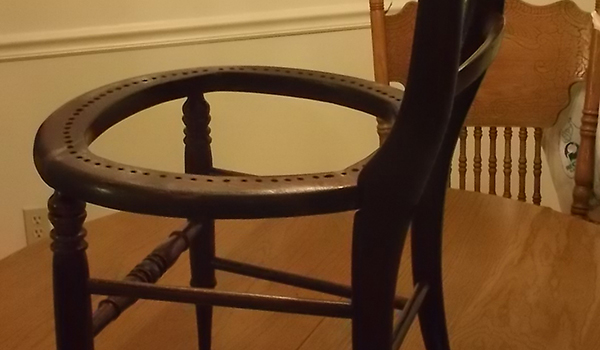
I have a set of oak dining chairs all of which wobble. These chairs have turned legs which fit into the seat and bent backs with spindles which also fit into the seats. Some of the chairs have been re-glued several times. I think I just don’t know how to do this job correctly. Can you recommend a book or an article which would tell me everything I need to know about fixing chairs? Junking the chairs and buying new ones is just too expensive! – Duke
Rob Johnstone: Well, Duke, this is a common problem, because chairs are complicated pieces of furniture, and the stresses that we put them through often cause their joints to break down over time. Commonly, once the glue joint has broken down, as the joints rub back and forth within the individual sockets (usually mortise and tenons of some sort, whether rectangular or drilled holes and spindles), the wood fibers break down, which means the joint gets even looser. Which brings us to the two important points of repairing a chair with wobbly joints. First, all the old glue needs to be removed from the weak joint. If, at that point, there is still a good tight wood-to-wood fit to the joint, you can just re-glue and clamp and you will have a successful repair.
If the wood fibers have broken down at the joint, you have two options. One is to clean up the joint and glue new wood into the mortise or stretcher hole and then re-drill or re-form the mortise, making a tight joint once again. The other possible solution is to once again clean up the joint to good wood fibers that are free of old glue. Then use epoxy to re-glue the joint. This is not as good an option as reforming the joint with good wood … but it can be successful.
Tim Inman: There is more to “re-glueing” a chair than just smearing on some new glue and slapping the parts back together, as you’ve discovered. One of the major troublemakers in furniture restoration work is wood movement. Over time, the parts of the joints have moved and changed sizes. The holes typically get a little bigger – or certainly go out of round. The tenons often shrink and become a little smaller. This is due to the wood drying out and other environmental factors – like the furniture being too close to a stove or even a fire, or maybe going through a flood. Most wood glues require close-fitting parts to work their best. Gap filling is the need for restoring old loose joints. There are a number of ways to fill the gaps. Some require cabinetmaking skills, some are pretty crude. Depending upon the value of the furniture you’re working with, and the skill/time/investment you have or are willing to make, you have different choices. If you have a valuable piece of furniture, and minimal skills or time to invest, I’d really recommend having the job done by a working professional. They will have a pallet of choices at hand to solve the individual joint problems as they work to correctly restore your furniture. Or, get some garage sale chairs and begin your learning curve on them! Save your best furniture for your more learned and experienced hand.







